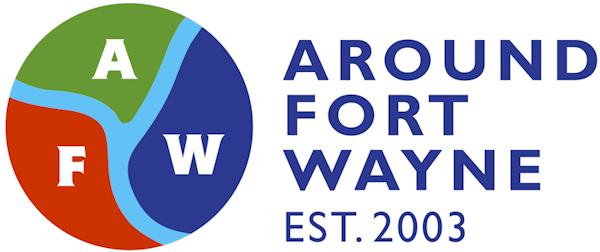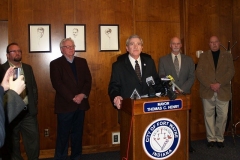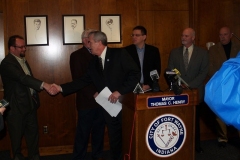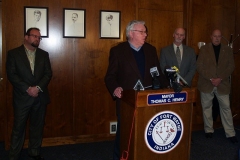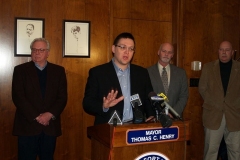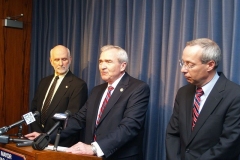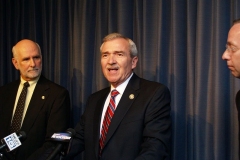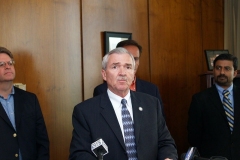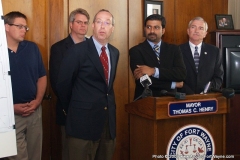![]()
News release from the Northeast Indiana Passenger Rail Association (NIPRA):
Don’t let the train pass Fort Wayne by
Passenger rail service benefits make project worth the price
Written by Fort Wayne City Councilman Geoff Paddock (D-5th) for the Fort Wayne Newspapers.
A broad coalition of support is building in Indiana and Ohio to bring passenger rail service back to the region – linking Fort Wayne with Chicago and Columbus, Ohio – at speeds up to 110 mph.
A feasibility study and business plan, released by the Northeast Indiana Passenger Rail Association, proposes a new model of rail service that is both efficient and affordable. If we make an initial investment in infrastructure improvements, we could see a self-sustaining rail system that would serve more than 2 million passengers a year.
The plan recommends 10 trains running daily between Chicago and Columbus with stops in several cities along the route, including Warsaw and Fort Wayne. This designated route has the potential to achieve priority status among those regional corridor projects being considered for funding by the Federal Railroad Administration. Such designation could make federal funding of 80 percent of the cost available for new track, signals and overpasses.
Chicago has become a hub-and-spoke system for upgraded passenger rail service over the past decade, connecting the third-largest U.S. city with many smaller cities across the Midwest. Currently, upgraded routes are being planned or funded between Chicago and Detroit, St. Louis, Milwaukee and the Quad Cities.
Decisions made in the next few months, will determine whether Fort Wayne and Columbus will become the next priority for passenger rail service from Chicago.
Investment in such a system would be an economic boon for northern Indiana. The initial construction cost is estimated at $550 million through Indiana, with the state picking up 20 percent of the cost over three to five years of construction. This cost is about $3.7 million per mile as compared to $15 million to $20 million per mile for interstate highway construction. New track, signals, overpasses and station work would allow for maximum speeds and safe integration with freight rail service.
The project would create the equivalent of 26,000 full-time jobs over 30 years throughout the corridor. Trains would attract 2.7 million riders by 2030 and add $700 million in household income and $2.7 billion in property values over that period. This is in addition to 12,000 temporary jobs created by construction.
Many Fort Wayne-area manufacturing companies producing parts for airplanes, trucks and automobiles can also make parts for locomotives and passenger cars.
Neighborhoods located near the expected stop at the Baker Street Train Station would become more valuable to young people who want to live and work near a full-service transportation hub—providing nearby Citilink bus service to all parts of our city, including Fort Wayne International Airport. With hundreds of people accessing downtown from throughout the region, Fort Wayne will have a wonderful opportunity to market our city for tourism and hospitality. We can more efficiently market our airport as well.
Perhaps most significant to the success of this system is that it is expected to operate at a profit by the third full year of operation. By the 10th year, it would show a profit of $28 million, according to the business plan.
This project, which is energy efficient and can save fossil fuels, has strong bipartisan support. Mayor Tom Henry and County Commissioners Linda Bloom, Therese Brown and Nelson Peters have been working with me to secure support from Gov. Mike Pence and other state and federal officials.
The next stop on this journey begins this week. The mayor and I are asking the City Council to appropriate $200,000 from the Legacy Fund to help pay for the next step – a Tier I Environmental Impact Study – for the two-state project. These Legacy funds are designated for transformational projects that will create jobs and improve our lifestyle. The cost for the study is about $1 million for each state.
Completion of this study, expected to take 18 to 24 months, will help ensure that Fort Wayne becomes the next destination served by the growing passenger rail movement. We cannot afford to miss this opportunity.
Please call your city council representative today and ask him to support funding a small portion of what could be a lasting legacy for the future of Fort Wayne (www.cityoffortwayne.org/city-council.html).
Follow the project on www.niprarail.org.
